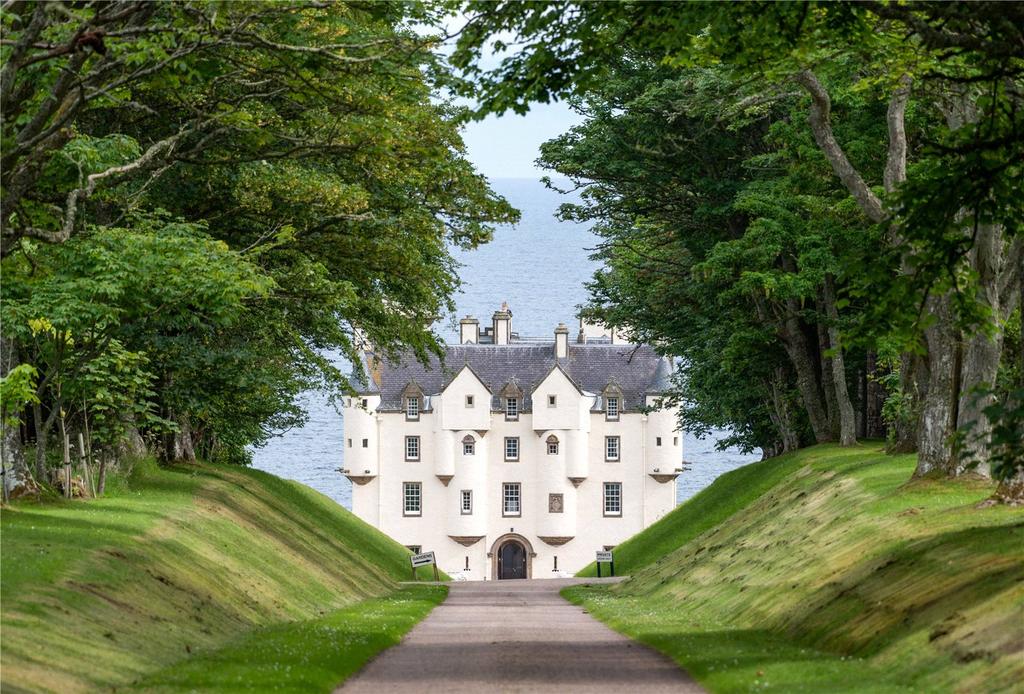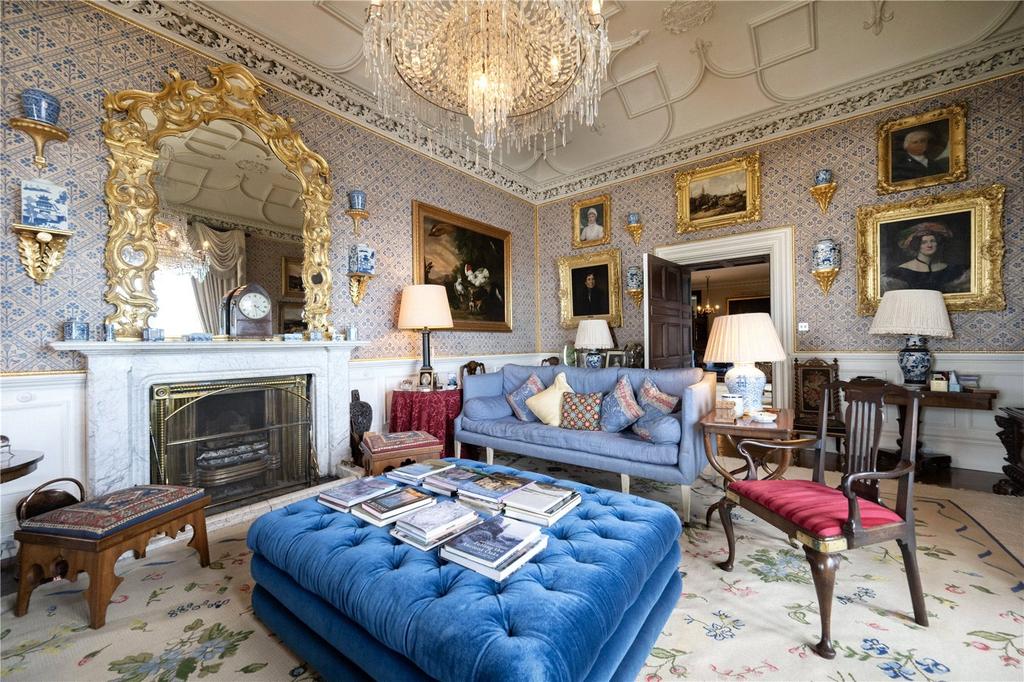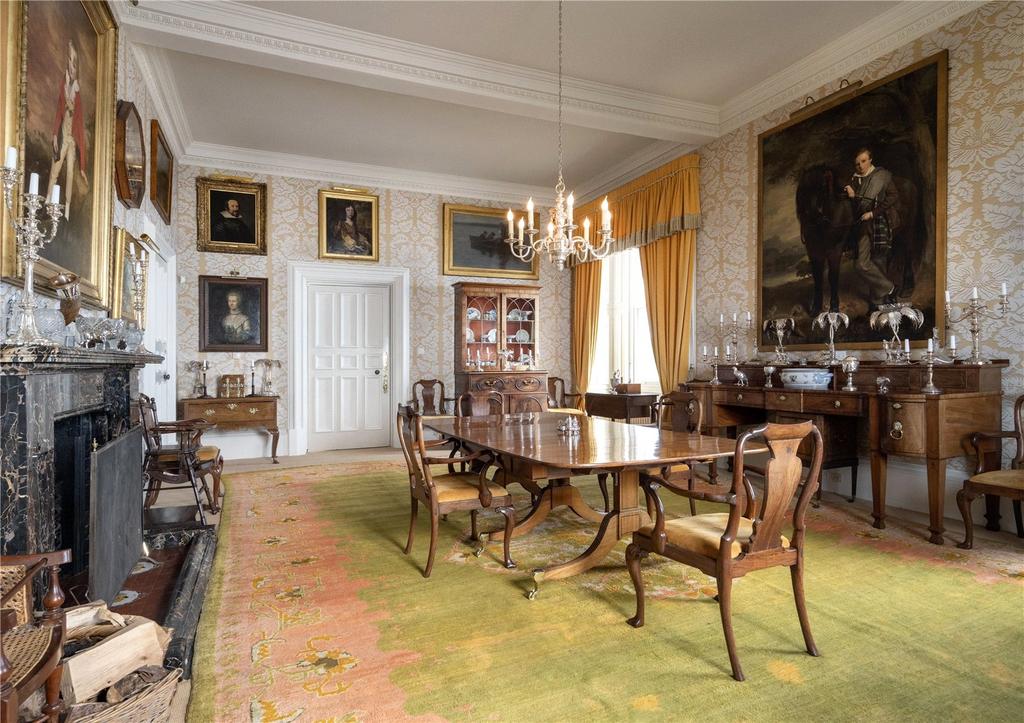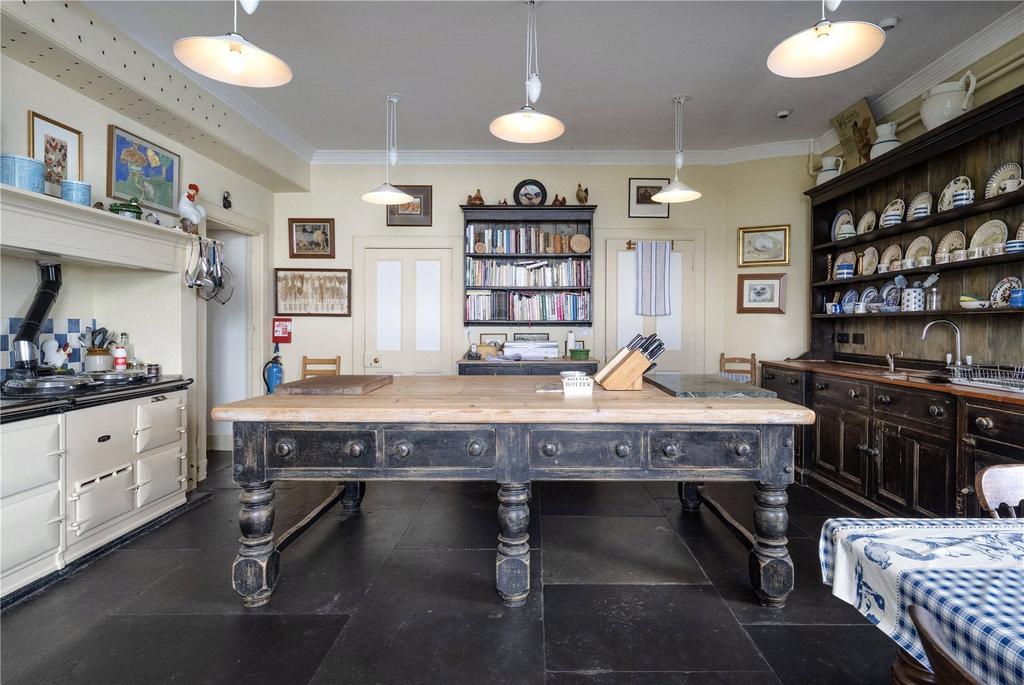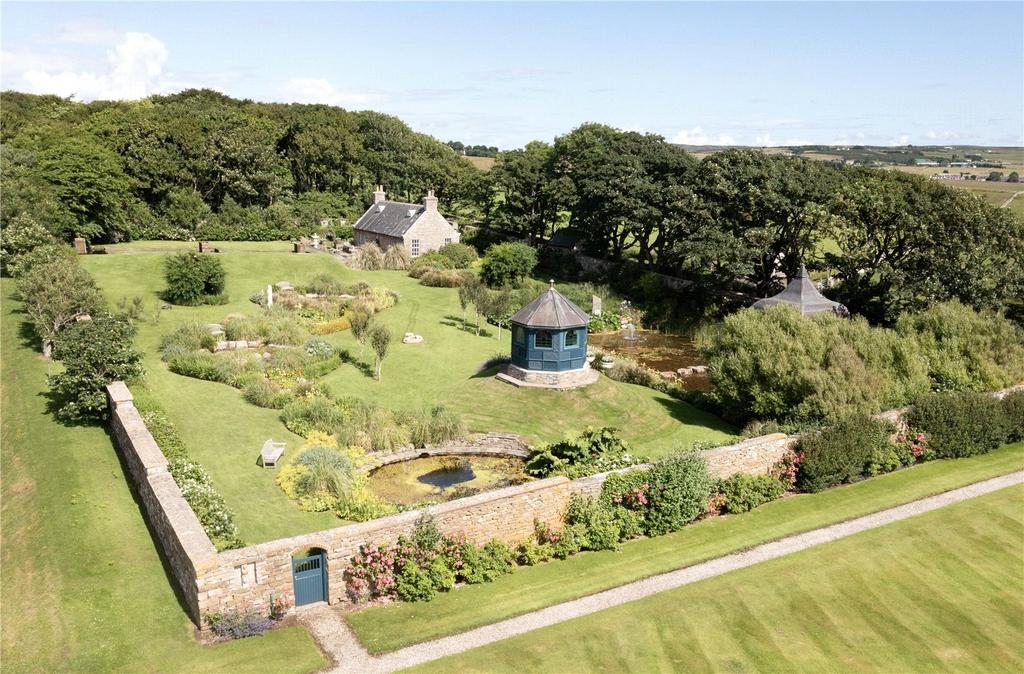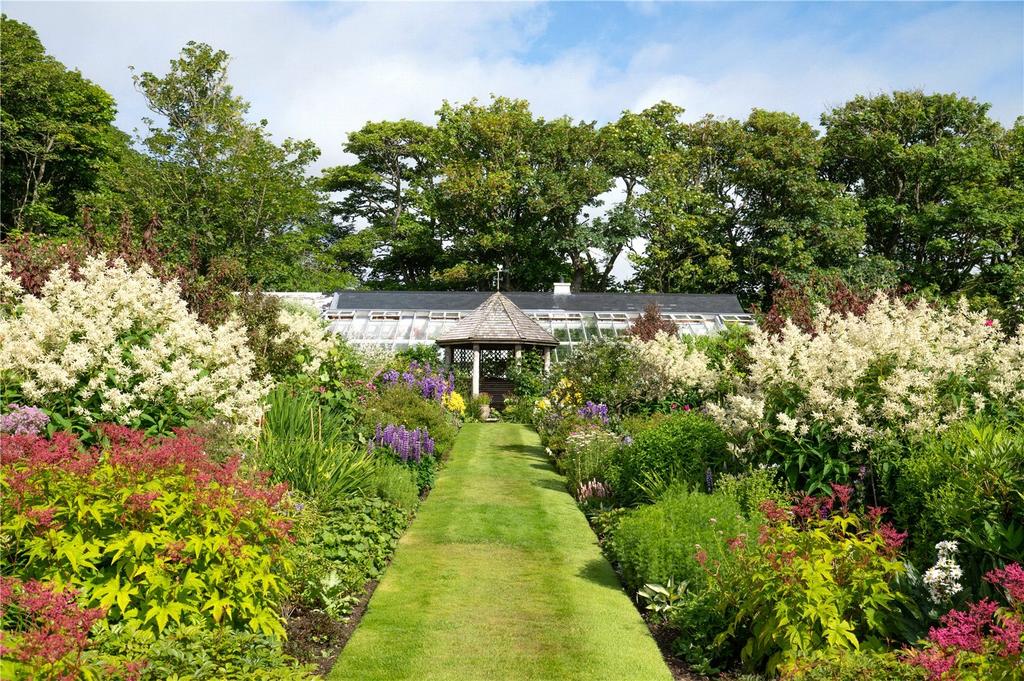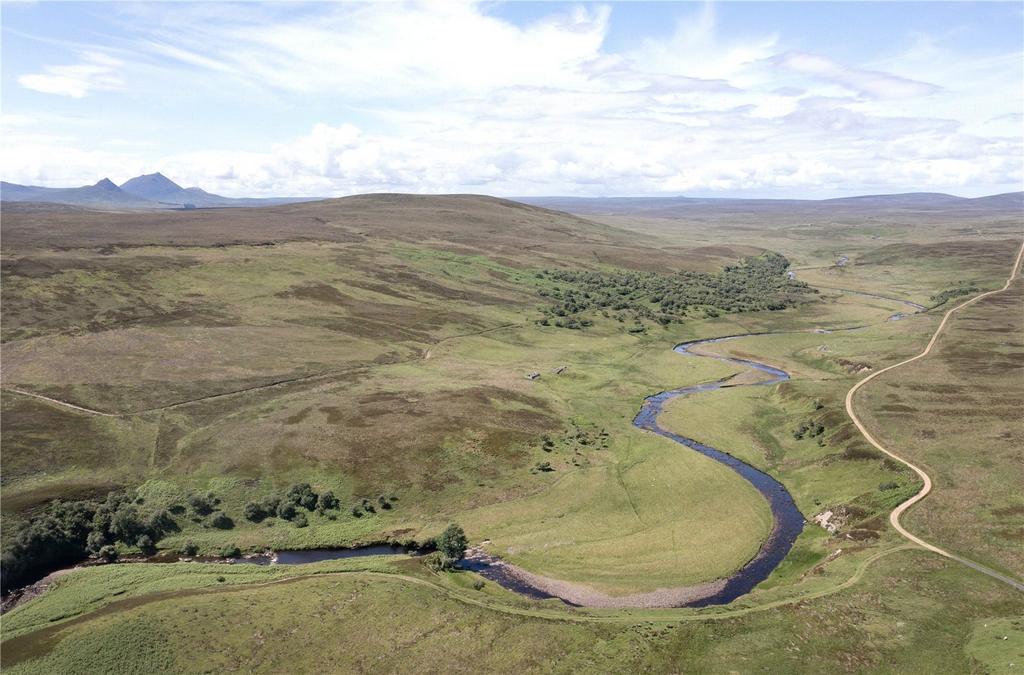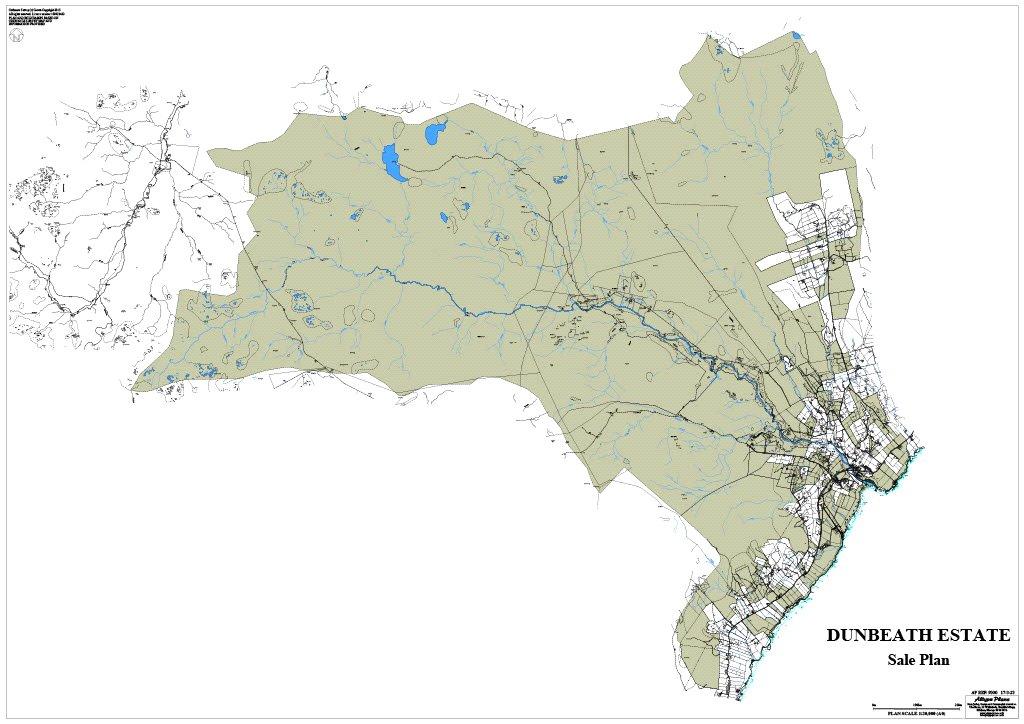No longer on the market
This property is no longer on the market
13 bedroom detached house
Premium display
Virtual tour
Under offer
Detached house
13 beds
9 baths
28,597.00 acre(s)
Key information
Tenure: Freehold
Council tax: Band H
Features and description
- Tenure: Freehold
- Dramatic coastal estate of uncompromising quality extending to 28,500 acres
- Magnificent ‘A’ Listed castle (3 reception rooms, 13 bedrooms and 9 bathrooms)
- Pair of walled gardens set within a designed landscape
- Extensive peatland restoration opportunities
- Walked up grouse moor and deer forest
- Driven pheasant shoot
- 12.5 miles of double bank fishing
- 500 acre in hand stock farm
- Renewables and development potential
- EPC Rating = E
Video tours
*UNDER OFFER*
SPECTACULAR COASTAL ESTATE WITH HISTORIC CASTLE IN DRAMATIC SCOTTISH SETTING
Description
Dunbeath Estate is a diverse all round estate of uncompromising quality, in a spectacular coastal location. The principal house is Dunbeath Castle, a magnificent castle on a cliff top setting above the north sea. The earliest parts of this Category A Listed castle date from the 15th century but it was extensively remodelled in the 1860s in the grand Baronial style when the grounds were also transformed.
Comprising 28,597 acres of truly spectacular topography, 12.5 miles of river flowing from source to mouth, four hill lochs and lochans and about four miles of rugged coastline, the estate represents an unparalleled combination of historic architecture, a unique landscape recognised globally and one of Scotland’s great coastal wildernesses.
Dunbeath offers an excellent variety of sport. The hill provides exhilarating walked up grouse shooting over pointers and challenging stalking for red deer. The steep sided Dunbeath Strath presents first class driven pheasant and partridge. Most unusually the estate also encompasses a full river system from catchment to ocean. The Dunbeath Water is a wild and beautiful river offering salmon and sea trout fishing. With this variety of wild sport, the months of August and September offer the rare privilege and challenge of obtaining a Macnab (bagging a salmon, stag and brace of grouse within one day between dawn and dusk from a single estate).
In all weathers Dunbeath is a paradise of moorland, riverside and coastline; a place to relish the absolute personal remoteness and to create unforgettable childhood memories of water sports and swimming in the crystal clear waters, catching fish or enjoying a picnic with family and friends in one of the three lunch huts or bothies across the estate.
As well as the superb sport it has to offer, the estate is a rich environmental and ecological habitat supporting a fascinating array of birdlife, wildlife and flora. It is therefore of significant conservation value with considerable potential for a variety of conservation or peatland restoration projects. These rich natural assets may provide exciting opportunities for income generation and capital growth.
In total there are 21 houses and cottages throughout the low ground of the estate, providing accommodation for employees, holiday cottages or long term lets. The style, construction and condition of the properties is relatively consistent, with the majority being of traditional stone construction. They also provide an additional income stream to the estate.
Dunbeath is currently under the same family ownership as the neighbouring Glutt Estate to the west. The Glutt Estate is also available separately on the market. When combined, these two magnificent but contrasting estates extend to about 35,900 acres in total, ranging from dramatic coastline and designed policies to the rugged wilderness of the Flow Country in the west. Details of The Glutt Estate can be obtained through the selling agents.
Dunbeath Castle dates from 1620 and occupies an ancient defensive site on a cliff-top promontory. In the mid 19th century David Bryce was commissioned to remodel the ancient castle and bring it up to date in the grand Baronial style of the time. His visionary landscaping idea of making the northern front of the castle symmetrical and approaching it down a ¾ mile long arrow straight drive in a classic "cut and fill" approach is a true masterpiece.
As one enters the gates past the lodge house one sees a glimpse of the front door of the castle some ¾ mile away, approaching via a steeply sloping 'keyhole' drive. The view gradually unfolds as two progressively higher banks topped with over hanging sycamores extend either side of the drive towards the castle, with the sea as a constant backdrop. The sea's horizon slowly changes the perspective along the way, making this the most dramatic of approaches. The Castle's cliff top location commands views far along the Caithness coast and across the North Sea and it stands as a striking architectural beacon, enhanced by the clarity of the pure northern coastal light.
The castle has a symmetrical northeast front defined by two matching bow stair turrets with corbelled bases. At the corners, on the upper floor, two angle bartizans with conical roofs add further character to this magnificent 'fairytale' castle. The walls, reaching five feet in thickness, are harled and whitewashed beneath a series of pitched slate roofs and crowstepped gables. Ornate dormers project above the wallheads. There are numerous gunloops and a square tower with a crenallated parapet in keeping with the castle’s defensive origins. Bryce's work also includes an extensive crenellated retaining terrace wall, with occasional bartizans and round terminal piers, forming a large gravelled forecourt and U-shaped enclosure to the castle.
Behind its grand exterior, Dunbeath Castle is a much cherished family home offering ample space for entertaining and accommodating guests in great comfort. The internal layout is extremely well appointed, with all the usual rooms one would expect of a house of this scale and period. All of the reception rooms sit on the eastern side the castle to take full advantage of the magnificent sea views and feature large windows flooding the rooms with natural light. In all there are 13 bedrooms, eight of which could be regarded as principal bedrooms and all bear the names of great naval battles above the doors.
An ornately carved turnpike staircase rises from the ground floor up to the second floor where there are two reception galleries (Lower and Upper Gallery) which are at the heart of their respective levels. A second service staircase leads from the basement all the way up to the attic floor. In keeping with Bryce’s work, there are a number of spiral staircases hidden within the many turrets and enormously thick walls.
Dunbeath Castle sits within a Designed Landscape which itself is regarded as a work of art with its skilfully contrived and dramatic approach and setting. The beautifully designed gardens and grounds are truly outstanding and form a wonderful contrast to the exposed and rugged natural surroundings. The centrepiece of the policies are a matching pair of walled gardens, one on either side of the sunken drive each extending to around an acre.
Location
Caithness is a coastal county lying in the north eastern corner of Great Britain, fringed to the north and east by dramatic sea cliffs and long sandy beaches. To the south and west it bounds the more rugged and mountainous county of Sutherland. It is a land of great moorland expanses, gentle rolling farmland and blanket peatland known as the 'Flow Country', the largest expanse of blanket bog in Europe. This is divided by the straths (river valleys) and by more fertile farm and croft land. Caithness is known for big skies and long summer nights. Such is its unique appeal, the late Queen Mother owned the Castle of Mey in Caithness as a holiday home for half a century.
Dunbeath lies 21 miles to the south of Wick on the A9 to the south of the small fishing village bearing the same name. A statue in the harbour commemorates the birthplace of Neil M.Gunn (1891-1973), author of The Silver Darlings and Highland River, many of whose novels are set in Dunbeath and its Strath. Gunn wrote of the intimate beauty of the Strath of Dunbeath: "In boyhood we get to know every square yard of it. We encompass it physically and our memories hold it. Birches, hazel trees for nutting, pools with trout and an occasionally visible salmon, river-flats with the wind on the bracken and disappearing rabbit scuts, a wealth of wild flower and small bird life, the soaring hawk, the unexpected roe, the ancient graveyard, thoughts of the folk who once lived far inland in straths and hollows, the past and the present held in a moment of day-dream." ('My Bit of Britain', 1941).
Dunbeath has a very rich archaeological landscape, being the site of numerous Iron Age brochs and an early medieval monastic site, and it was used by the Vikings as a harbour for their longboats and trading vessels. Although granted the title of Royal Burgh in 1589, it was in the 1800s that Wick enjoyed its greatest prosperity as a thriving herring port, in time becoming the busiest in Europe, boasting a fleet of 1,120 vessels at its peak around 1900.
While Caithness is relatively isolated geographically (its remoteness is central to its extraordinary unspoilt beauty), it can be reached with relative ease. Wick has an airport (23 miles) suitable for private jets, plus there are flights to and from Aberdeen (Eastern Airways), with onward connections to a variety of UK destinations. Helicopters can land on the lawn at Dunbeath Castle, and there is a good train service from Inverness (83 miles) which also has an airport (89 miles). The A9 provides excellent access by road from the south and the railway stations in Wick and Thurso (27 miles) offer a daily service to Inverness, from where Aberdeen, Edinburgh and the south are directly accessible.
Wick also provides a wide range of facilities and professional services, supermarkets, a hospital, and primary and secondary education. Inverness sits 82 miles to the south and provides all the services expected of a major regional city.
In addition to Dunbeath’s own fine sport, the wider area is recognised for its exciting country pursuits, which include salmon fishing on numerous rivers such as the Thurso, Helmsdale, Halladale, Forss, Borgie and Naver. Stalking and grouse shooting can also be taken on the varied terrain of other local estates. There are several golf courses locally at Thurso, Wick and Lybster, and further down the coast at Helmsdale, Brora, Golspie and Royal Dornoch.
Square Footage: 17,000 sq ft
Acreage: 28597 Acres
Directions
By Road - From Inverness, follow the A9 north towards Thurso. After passing through the town of Helmsdale, continue following the A9 for approximately 14 miles before turning right signposted towards Dunbeath. Follow this road for 100m before turning right onto Campbell Avenue. Continue on this road for half a mile before turning left onto the drive leading down to Dunbeath Castle.
The postcode for sat nav purposes is KW6 6EY. what3words: ///column.award.nodded
By Air - Inverness is the closest international airport from where helicopters and cars can be hired. Aberdeen airport has daily scheduled flights (Sunday-Friday) to and from Wick (23 miles from Dunbeath Castle). Other Scottish international airports include Edinburgh and Glasgow. There are daily flights from London to Inverness airport (90 miles from Dunbeath Castle) from where a private driver can be arranged.
Aberdeen -[use Contact Agent Button] Wick -[use Contact Agent Button] Inverness -[use Contact Agent Button]
Helicopter Hire - For helicopter charter from most Scottish airports contact PDG Helicopters on[use Contact Agent Button].
By Rail - From Edinburgh and Glasgow it is possible to get a train to Inverness. Change here for a train to Helmsdale, the closest station to Dunbeath Castle (14 miles).
Additional Info
Farming - Dunbeath Mains is the in-hand farm for the estate which up until mid-2023, carried a flock of 800 breeding Cheviot ewes and a herd of 70 suckler cows across approximately 575 acres of pasture and rough grazing. The farm is currently being managed in the short term by a local farmer. The land is largely situated towards the southeastern corner of the estate and runs from the shoreline to a height of about 30 meters above sea level. It has mainly easterly aspects and is largely classified as Grades 4 and 5. The in-bye fields are well-fenced and are serviced by either water troughs or natural supplies. Approximately 200 acres have been cut for silage in the past.
Sport & Fishing - Dunbeath offers the sportsman varied and exciting walked-up grouse shooting amidst a breathtaking and vast landscape. In common with many Caithness and Sutherland moors, the grouse are walked-up over pointers providing smaller teams of guns with exhilarating sport combined with the fascinating spectacle of watching the dogs in action. Bags are generally in the order of three to five brace per day and tend to be shot between August and September. Typically 20 - 25 days are shot each season and the average bag for the last 10 years has been 64 brace. The Caithness moors are also famed for their perfect conditions for falconry. The absence of trees, relatively flat landscape and smaller covey sizes make this the ideal hunting environment for falcons.
The low ground shooting is largely focused on the land around Balcraggie Lodge and the dramatic steep sided gullies and slopes rising up from the Dunbeath Water. The wooded and sheltered banks of the river provide an ideal habitat for holding pheasants and are in stark contrast to the open moorland further west.
The Dunbeath Deer Forest forms the western portion of the estate and comprises an interesting and varied hill which extends to approximately 20,000 acres. The terrain offers exciting and challenging stalking, and has a ten year average cull of 40 stags and 59 hinds. The forest sits in a spectacular landscape between the hills of Ben Alisky (348m) to the north and Morven (706m) and the Maiden Pap (484m) to the south.
The Dunbeath Water offers excellent salmon and sea trout fishing and is one of the few rivers in Scotland to be under single ownership from source to sea. It also includes the netting rights in order to help preserve salmon stocks. This modest but prolific spate river stretches from Loch Braigh na h-Aibhne in the most westerly corner of the estate to the harbour of Dunbeath, some 16 miles in length and includes about 50 fishable pools. Numerous smaller tributaries flow into the main body of the river, the two most significant being the Achorn and Houstry burns. Flow is also maintained by feeds from two lochs, Loch Dubh and Loch Braec. It is understood that in the 1920s, both these lochs were equipped with hatches as a buffer against very low flow conditions during times of drought; these have been maintained to this day.
Peatland Restoration - Approximately 15,000 acres of Dunbeath are situated within the Caithness and Sutherland Special Protection Area (SPA), Special Area of Conservation (SAC), RAMSAR Site and Site of Special Scientific Interest (SSSI). The vast majority of the estate falls within Caithness Flow Country. The Flow Country is Europe’s largest expanse of blanket bog and is reported to store 400 million tonnes of carbon. This sale offers an owner the opportunity to deliver significant nature-based solutions through the restoration and management of peatlands and to conserve and enhance this important upland habitat. The Peatland Code currently provides a voluntary mechanism for carbon finance to peatland restoration work throughout the UK. The vast majority of the moorland at Dunbeath is blanket bog, made up of nationally important Class 1 carbon-rich soils, deep peat and priority peatland habitat of high conservation value. Caledonian Climate Partners Limited is working with Dunbeath Estate to develop peatland restoration projects across areas of degraded peatland on the Deer Forest. The site has been surveyed and 1,850 acres have been identified as suitable for restoration. The site lies on an area of blanket bog at an altitude of between 162 and 301 meters with an average peat depth of 196 cm with depths of up to 7 meters found in places. Carbon calculations estimate the claimable emissions reduction could be 207,000 tCO2e over a 100 year project duration. In addition there may be up to a further 8,500 acres of degraded peatland across the estate which may be suitable for a restoration scheme. This additional area is subject to common grazing rights and any project would require the agreement of the crofters.
SPECTACULAR COASTAL ESTATE WITH HISTORIC CASTLE IN DRAMATIC SCOTTISH SETTING
Description
Dunbeath Estate is a diverse all round estate of uncompromising quality, in a spectacular coastal location. The principal house is Dunbeath Castle, a magnificent castle on a cliff top setting above the north sea. The earliest parts of this Category A Listed castle date from the 15th century but it was extensively remodelled in the 1860s in the grand Baronial style when the grounds were also transformed.
Comprising 28,597 acres of truly spectacular topography, 12.5 miles of river flowing from source to mouth, four hill lochs and lochans and about four miles of rugged coastline, the estate represents an unparalleled combination of historic architecture, a unique landscape recognised globally and one of Scotland’s great coastal wildernesses.
Dunbeath offers an excellent variety of sport. The hill provides exhilarating walked up grouse shooting over pointers and challenging stalking for red deer. The steep sided Dunbeath Strath presents first class driven pheasant and partridge. Most unusually the estate also encompasses a full river system from catchment to ocean. The Dunbeath Water is a wild and beautiful river offering salmon and sea trout fishing. With this variety of wild sport, the months of August and September offer the rare privilege and challenge of obtaining a Macnab (bagging a salmon, stag and brace of grouse within one day between dawn and dusk from a single estate).
In all weathers Dunbeath is a paradise of moorland, riverside and coastline; a place to relish the absolute personal remoteness and to create unforgettable childhood memories of water sports and swimming in the crystal clear waters, catching fish or enjoying a picnic with family and friends in one of the three lunch huts or bothies across the estate.
As well as the superb sport it has to offer, the estate is a rich environmental and ecological habitat supporting a fascinating array of birdlife, wildlife and flora. It is therefore of significant conservation value with considerable potential for a variety of conservation or peatland restoration projects. These rich natural assets may provide exciting opportunities for income generation and capital growth.
In total there are 21 houses and cottages throughout the low ground of the estate, providing accommodation for employees, holiday cottages or long term lets. The style, construction and condition of the properties is relatively consistent, with the majority being of traditional stone construction. They also provide an additional income stream to the estate.
Dunbeath is currently under the same family ownership as the neighbouring Glutt Estate to the west. The Glutt Estate is also available separately on the market. When combined, these two magnificent but contrasting estates extend to about 35,900 acres in total, ranging from dramatic coastline and designed policies to the rugged wilderness of the Flow Country in the west. Details of The Glutt Estate can be obtained through the selling agents.
Dunbeath Castle dates from 1620 and occupies an ancient defensive site on a cliff-top promontory. In the mid 19th century David Bryce was commissioned to remodel the ancient castle and bring it up to date in the grand Baronial style of the time. His visionary landscaping idea of making the northern front of the castle symmetrical and approaching it down a ¾ mile long arrow straight drive in a classic "cut and fill" approach is a true masterpiece.
As one enters the gates past the lodge house one sees a glimpse of the front door of the castle some ¾ mile away, approaching via a steeply sloping 'keyhole' drive. The view gradually unfolds as two progressively higher banks topped with over hanging sycamores extend either side of the drive towards the castle, with the sea as a constant backdrop. The sea's horizon slowly changes the perspective along the way, making this the most dramatic of approaches. The Castle's cliff top location commands views far along the Caithness coast and across the North Sea and it stands as a striking architectural beacon, enhanced by the clarity of the pure northern coastal light.
The castle has a symmetrical northeast front defined by two matching bow stair turrets with corbelled bases. At the corners, on the upper floor, two angle bartizans with conical roofs add further character to this magnificent 'fairytale' castle. The walls, reaching five feet in thickness, are harled and whitewashed beneath a series of pitched slate roofs and crowstepped gables. Ornate dormers project above the wallheads. There are numerous gunloops and a square tower with a crenallated parapet in keeping with the castle’s defensive origins. Bryce's work also includes an extensive crenellated retaining terrace wall, with occasional bartizans and round terminal piers, forming a large gravelled forecourt and U-shaped enclosure to the castle.
Behind its grand exterior, Dunbeath Castle is a much cherished family home offering ample space for entertaining and accommodating guests in great comfort. The internal layout is extremely well appointed, with all the usual rooms one would expect of a house of this scale and period. All of the reception rooms sit on the eastern side the castle to take full advantage of the magnificent sea views and feature large windows flooding the rooms with natural light. In all there are 13 bedrooms, eight of which could be regarded as principal bedrooms and all bear the names of great naval battles above the doors.
An ornately carved turnpike staircase rises from the ground floor up to the second floor where there are two reception galleries (Lower and Upper Gallery) which are at the heart of their respective levels. A second service staircase leads from the basement all the way up to the attic floor. In keeping with Bryce’s work, there are a number of spiral staircases hidden within the many turrets and enormously thick walls.
Dunbeath Castle sits within a Designed Landscape which itself is regarded as a work of art with its skilfully contrived and dramatic approach and setting. The beautifully designed gardens and grounds are truly outstanding and form a wonderful contrast to the exposed and rugged natural surroundings. The centrepiece of the policies are a matching pair of walled gardens, one on either side of the sunken drive each extending to around an acre.
Location
Caithness is a coastal county lying in the north eastern corner of Great Britain, fringed to the north and east by dramatic sea cliffs and long sandy beaches. To the south and west it bounds the more rugged and mountainous county of Sutherland. It is a land of great moorland expanses, gentle rolling farmland and blanket peatland known as the 'Flow Country', the largest expanse of blanket bog in Europe. This is divided by the straths (river valleys) and by more fertile farm and croft land. Caithness is known for big skies and long summer nights. Such is its unique appeal, the late Queen Mother owned the Castle of Mey in Caithness as a holiday home for half a century.
Dunbeath lies 21 miles to the south of Wick on the A9 to the south of the small fishing village bearing the same name. A statue in the harbour commemorates the birthplace of Neil M.Gunn (1891-1973), author of The Silver Darlings and Highland River, many of whose novels are set in Dunbeath and its Strath. Gunn wrote of the intimate beauty of the Strath of Dunbeath: "In boyhood we get to know every square yard of it. We encompass it physically and our memories hold it. Birches, hazel trees for nutting, pools with trout and an occasionally visible salmon, river-flats with the wind on the bracken and disappearing rabbit scuts, a wealth of wild flower and small bird life, the soaring hawk, the unexpected roe, the ancient graveyard, thoughts of the folk who once lived far inland in straths and hollows, the past and the present held in a moment of day-dream." ('My Bit of Britain', 1941).
Dunbeath has a very rich archaeological landscape, being the site of numerous Iron Age brochs and an early medieval monastic site, and it was used by the Vikings as a harbour for their longboats and trading vessels. Although granted the title of Royal Burgh in 1589, it was in the 1800s that Wick enjoyed its greatest prosperity as a thriving herring port, in time becoming the busiest in Europe, boasting a fleet of 1,120 vessels at its peak around 1900.
While Caithness is relatively isolated geographically (its remoteness is central to its extraordinary unspoilt beauty), it can be reached with relative ease. Wick has an airport (23 miles) suitable for private jets, plus there are flights to and from Aberdeen (Eastern Airways), with onward connections to a variety of UK destinations. Helicopters can land on the lawn at Dunbeath Castle, and there is a good train service from Inverness (83 miles) which also has an airport (89 miles). The A9 provides excellent access by road from the south and the railway stations in Wick and Thurso (27 miles) offer a daily service to Inverness, from where Aberdeen, Edinburgh and the south are directly accessible.
Wick also provides a wide range of facilities and professional services, supermarkets, a hospital, and primary and secondary education. Inverness sits 82 miles to the south and provides all the services expected of a major regional city.
In addition to Dunbeath’s own fine sport, the wider area is recognised for its exciting country pursuits, which include salmon fishing on numerous rivers such as the Thurso, Helmsdale, Halladale, Forss, Borgie and Naver. Stalking and grouse shooting can also be taken on the varied terrain of other local estates. There are several golf courses locally at Thurso, Wick and Lybster, and further down the coast at Helmsdale, Brora, Golspie and Royal Dornoch.
Square Footage: 17,000 sq ft
Acreage: 28597 Acres
Directions
By Road - From Inverness, follow the A9 north towards Thurso. After passing through the town of Helmsdale, continue following the A9 for approximately 14 miles before turning right signposted towards Dunbeath. Follow this road for 100m before turning right onto Campbell Avenue. Continue on this road for half a mile before turning left onto the drive leading down to Dunbeath Castle.
The postcode for sat nav purposes is KW6 6EY. what3words: ///column.award.nodded
By Air - Inverness is the closest international airport from where helicopters and cars can be hired. Aberdeen airport has daily scheduled flights (Sunday-Friday) to and from Wick (23 miles from Dunbeath Castle). Other Scottish international airports include Edinburgh and Glasgow. There are daily flights from London to Inverness airport (90 miles from Dunbeath Castle) from where a private driver can be arranged.
Aberdeen -[use Contact Agent Button] Wick -[use Contact Agent Button] Inverness -[use Contact Agent Button]
Helicopter Hire - For helicopter charter from most Scottish airports contact PDG Helicopters on[use Contact Agent Button].
By Rail - From Edinburgh and Glasgow it is possible to get a train to Inverness. Change here for a train to Helmsdale, the closest station to Dunbeath Castle (14 miles).
Additional Info
Farming - Dunbeath Mains is the in-hand farm for the estate which up until mid-2023, carried a flock of 800 breeding Cheviot ewes and a herd of 70 suckler cows across approximately 575 acres of pasture and rough grazing. The farm is currently being managed in the short term by a local farmer. The land is largely situated towards the southeastern corner of the estate and runs from the shoreline to a height of about 30 meters above sea level. It has mainly easterly aspects and is largely classified as Grades 4 and 5. The in-bye fields are well-fenced and are serviced by either water troughs or natural supplies. Approximately 200 acres have been cut for silage in the past.
Sport & Fishing - Dunbeath offers the sportsman varied and exciting walked-up grouse shooting amidst a breathtaking and vast landscape. In common with many Caithness and Sutherland moors, the grouse are walked-up over pointers providing smaller teams of guns with exhilarating sport combined with the fascinating spectacle of watching the dogs in action. Bags are generally in the order of three to five brace per day and tend to be shot between August and September. Typically 20 - 25 days are shot each season and the average bag for the last 10 years has been 64 brace. The Caithness moors are also famed for their perfect conditions for falconry. The absence of trees, relatively flat landscape and smaller covey sizes make this the ideal hunting environment for falcons.
The low ground shooting is largely focused on the land around Balcraggie Lodge and the dramatic steep sided gullies and slopes rising up from the Dunbeath Water. The wooded and sheltered banks of the river provide an ideal habitat for holding pheasants and are in stark contrast to the open moorland further west.
The Dunbeath Deer Forest forms the western portion of the estate and comprises an interesting and varied hill which extends to approximately 20,000 acres. The terrain offers exciting and challenging stalking, and has a ten year average cull of 40 stags and 59 hinds. The forest sits in a spectacular landscape between the hills of Ben Alisky (348m) to the north and Morven (706m) and the Maiden Pap (484m) to the south.
The Dunbeath Water offers excellent salmon and sea trout fishing and is one of the few rivers in Scotland to be under single ownership from source to sea. It also includes the netting rights in order to help preserve salmon stocks. This modest but prolific spate river stretches from Loch Braigh na h-Aibhne in the most westerly corner of the estate to the harbour of Dunbeath, some 16 miles in length and includes about 50 fishable pools. Numerous smaller tributaries flow into the main body of the river, the two most significant being the Achorn and Houstry burns. Flow is also maintained by feeds from two lochs, Loch Dubh and Loch Braec. It is understood that in the 1920s, both these lochs were equipped with hatches as a buffer against very low flow conditions during times of drought; these have been maintained to this day.
Peatland Restoration - Approximately 15,000 acres of Dunbeath are situated within the Caithness and Sutherland Special Protection Area (SPA), Special Area of Conservation (SAC), RAMSAR Site and Site of Special Scientific Interest (SSSI). The vast majority of the estate falls within Caithness Flow Country. The Flow Country is Europe’s largest expanse of blanket bog and is reported to store 400 million tonnes of carbon. This sale offers an owner the opportunity to deliver significant nature-based solutions through the restoration and management of peatlands and to conserve and enhance this important upland habitat. The Peatland Code currently provides a voluntary mechanism for carbon finance to peatland restoration work throughout the UK. The vast majority of the moorland at Dunbeath is blanket bog, made up of nationally important Class 1 carbon-rich soils, deep peat and priority peatland habitat of high conservation value. Caledonian Climate Partners Limited is working with Dunbeath Estate to develop peatland restoration projects across areas of degraded peatland on the Deer Forest. The site has been surveyed and 1,850 acres have been identified as suitable for restoration. The site lies on an area of blanket bog at an altitude of between 162 and 301 meters with an average peat depth of 196 cm with depths of up to 7 meters found in places. Carbon calculations estimate the claimable emissions reduction could be 207,000 tCO2e over a 100 year project duration. In addition there may be up to a further 8,500 acres of degraded peatland across the estate which may be suitable for a restoration scheme. This additional area is subject to common grazing rights and any project would require the agreement of the crofters.
About this agent

It pays to specialise in a property market as broad as the one served by Savills Edinburgh. From prime commercial offices and out of town retail parks to the cream of city property, to country houses and sporting estates, the choice is as large and varied as the area we cover. That’s why we have dedicated teams specialising in prime residential property, farms and estates, land sales, commercial property, valuation and planning, right across the full property spectrum.

